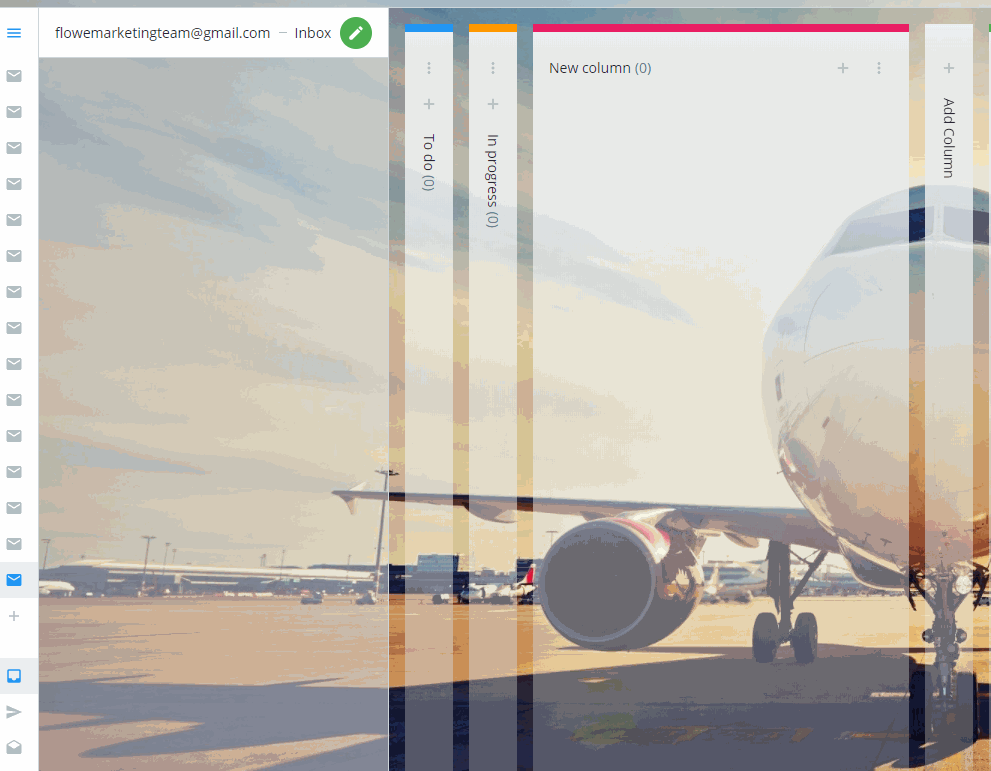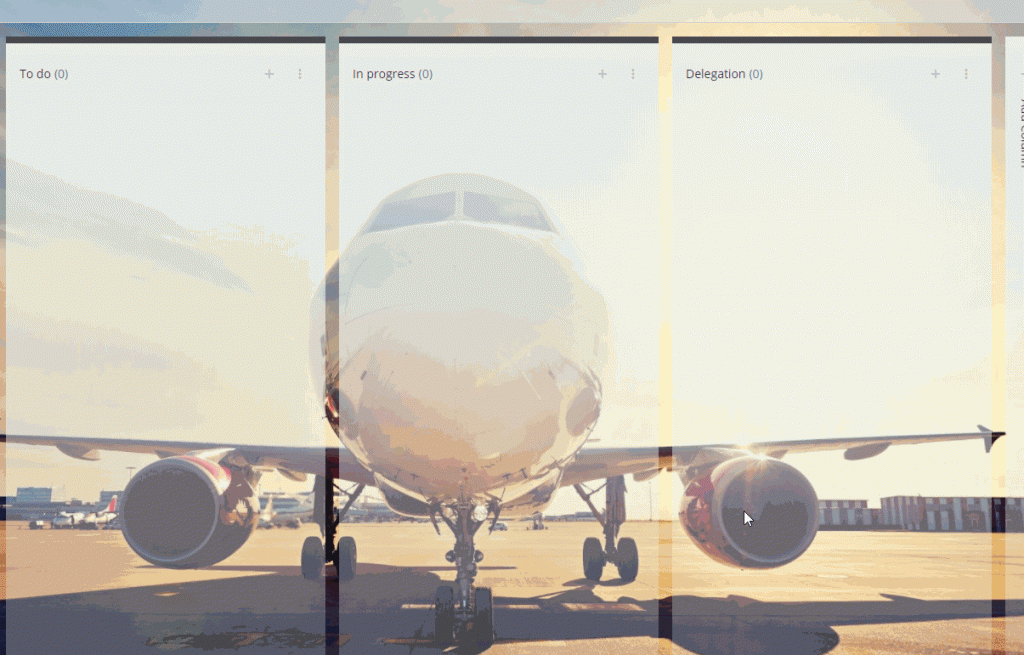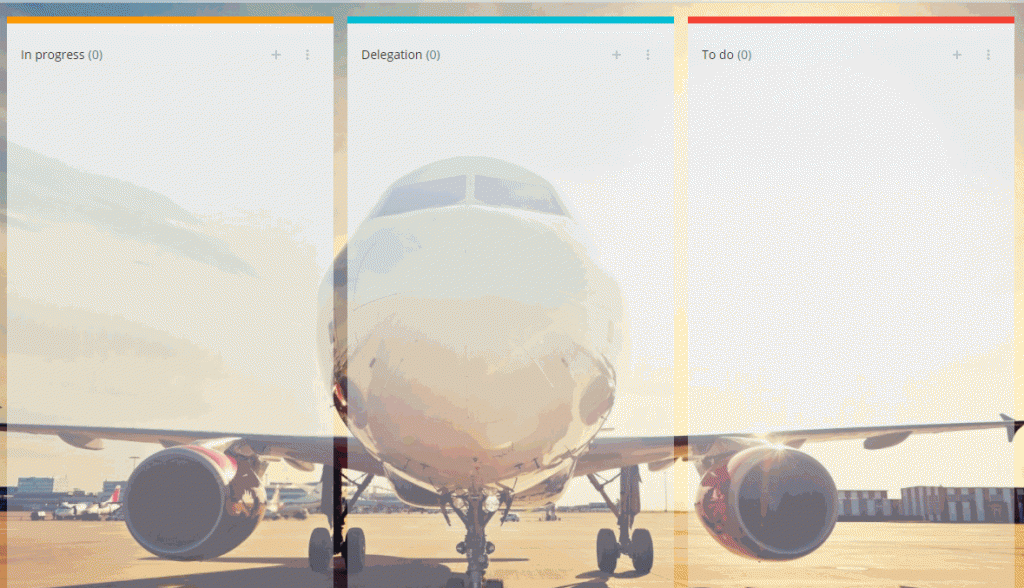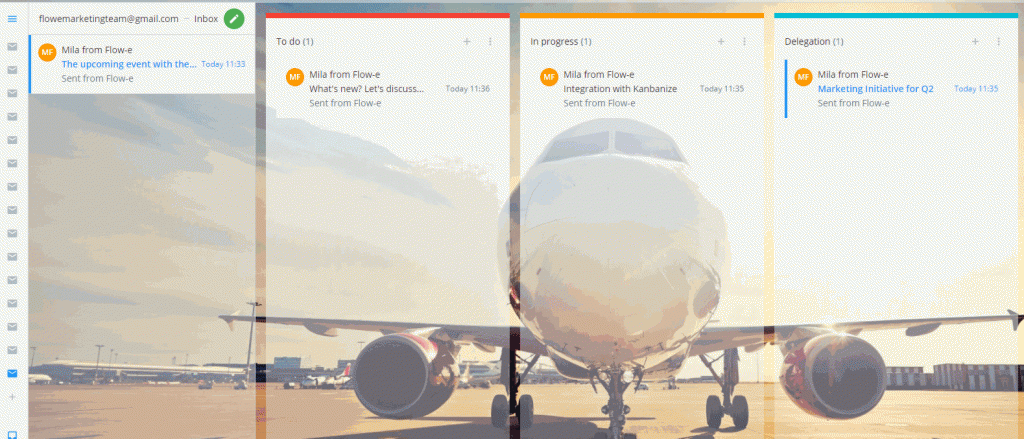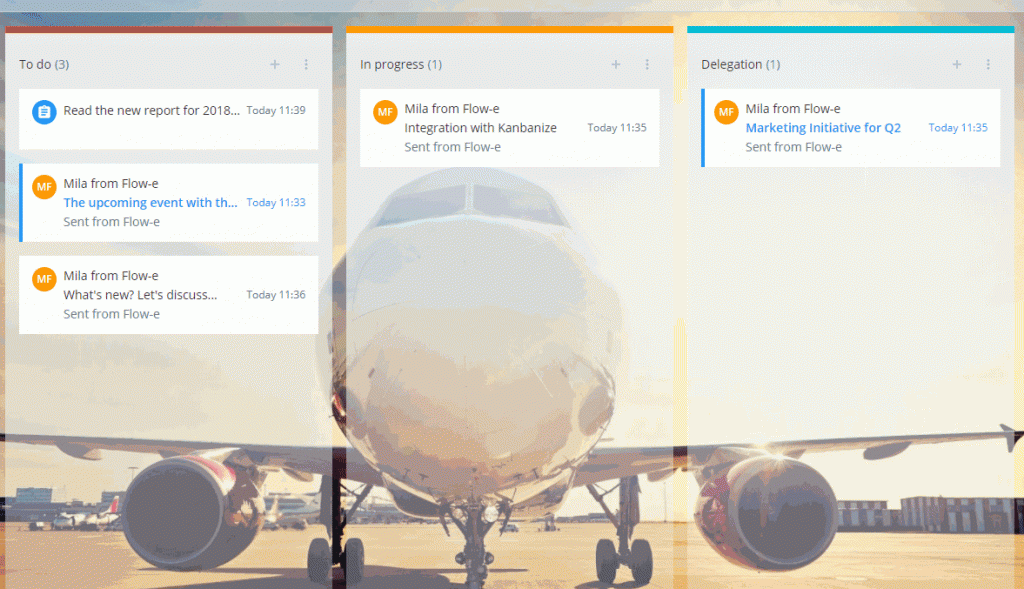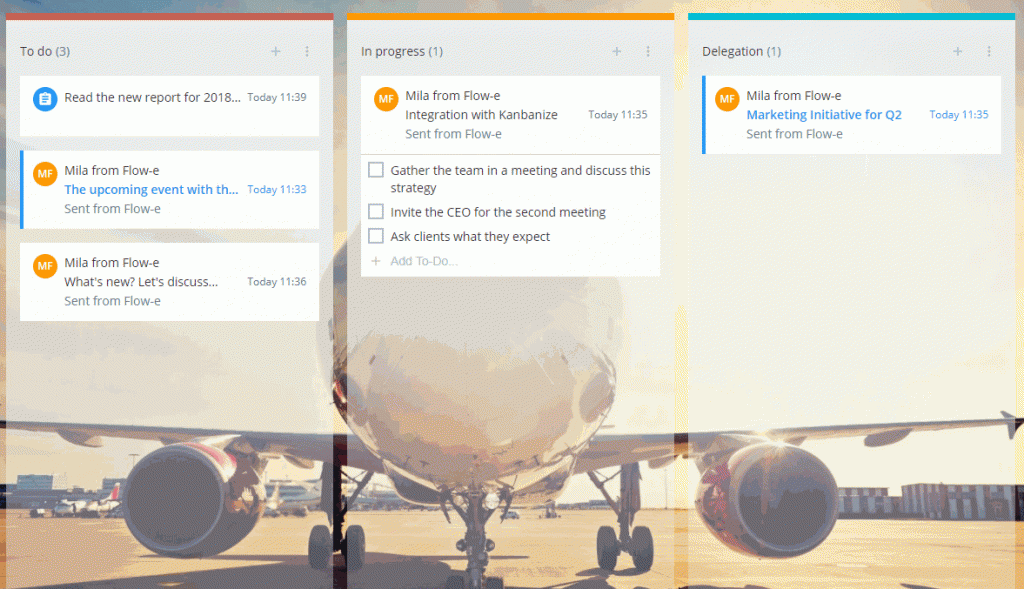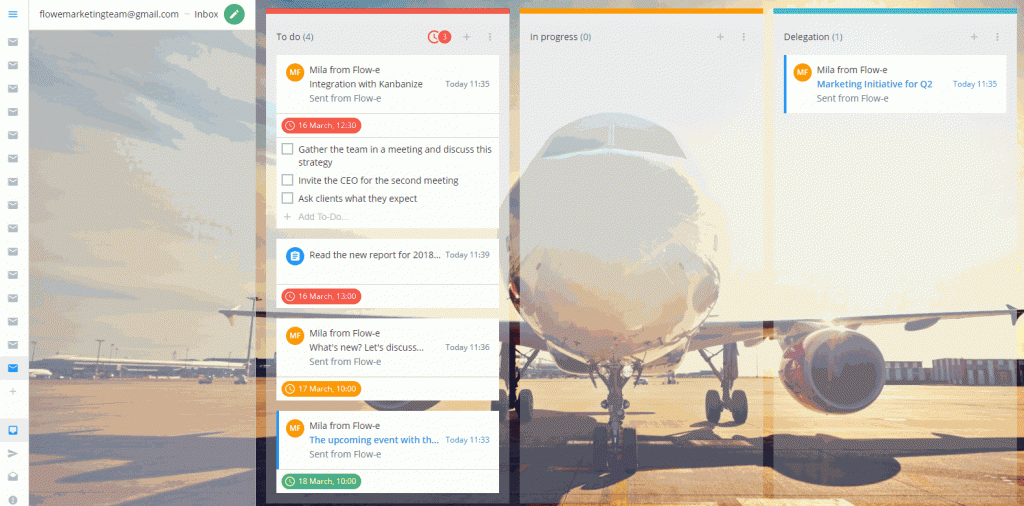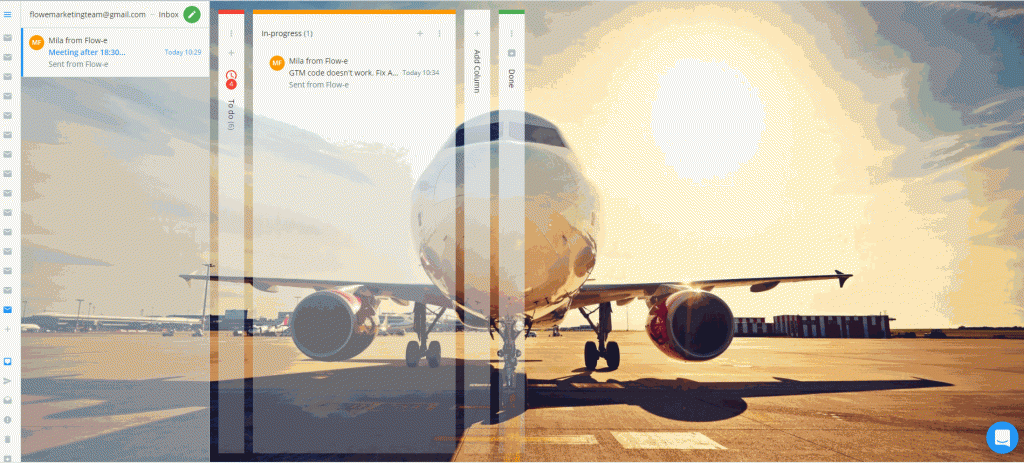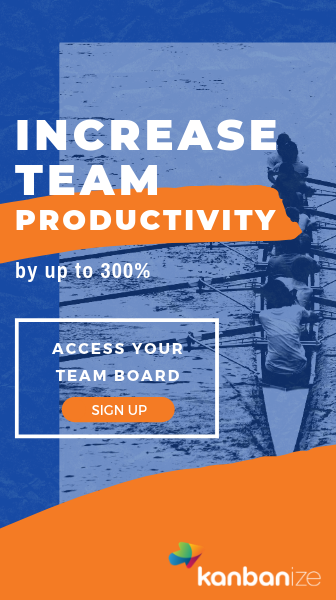It is with great sadness that we announce the discontinuation of Flow-e for Gmail. As of 1st January 2020, Flow-e for Gmail will stop working. Learn More.
What is Personal Kanban for Gmail?
Not many users are familiar with the fact that you can have a Kanban view in your Gmail email client.
With the right personal Kanban board tool, you can quickly create a Kanban board inside your Gmail inbox.
The Kanban board for Gmail lets you convert your emails into Kanban cards and map your workflow in a highly visual manner.
Use Kanban for Gmail to Increase Productivity
If you’re using personal kanban boards to visualize your to-do list and track productivity, then you already know how it simplifies and streamlines managing and monitoring tasks.
Kanban boards help you work more efficiently and keep your attention on your tasks, instead of on administering your to-do list.
If you aren’t, and struggling to keep your days productive and your work organized, it might be time to look into this simple and intuitive system.
How to Get Started with Personal Kanban for Gmail?
Your inbox isn’t theoretically a to-do list, and many emails are things you have to act on or go back to at a later stage.
Despite labeling, starring, and all the other email tactics you use, it’s not easy staying on top of all those essential tasks mainly when they all are in one long list.
You can use an app such as Flow-e which can be integrated with Gmail and can be treated as a Kanban for Gmail.
Using a Gmail kanban application speeds work and productivity. You can visualize emails and tasks in progress, identify backlogs, and stay organized, all within the familiar structure of Gmail, without ever leaving your email.
Once you have logged in to Flow-e, you will see a Kanban board with your first three columns ready.
Step 1) Create new columns and use them to map your workflow
Step 2) Rename existing column titles with just one click
Step 3) Apply different colors to your columns for better visualization. Use colors to signalize to your brain the stages and importance of each column
Step 4) You can drag and reorder your columns accordingly
Once you are ready with the column setup, let’s create our first Kanban cards and learn how to move them from left to right.
The process starts from the leftmost column, usually named as ‘To-do.” This is where your tasks and ideas begin.
· You can drag an email from the feed to the “To-do” column, or you can create a new task from the “+” menu (make sure that all Power-ups are enabled).
· You can further clarify your emails and tasks and break them down into specific steps. Use the power-up icon to choose “Add To-do.” You can also open an email or a task to add additional notes.
· If the task is time sensitive, add another power-up – Due Date. This option is convenient because as the deadline approaches, you will see the Due Date icon changing its color from green to orange and red.
Now that you have gone through your email feed and you have already moved and created all the task in the “To-do” column, we have to pull one card and move it to the next column “In-progress.”
Now that you have gone through your email feed and you have already moved and created tasks in the “To-do” column, we have to pull one card and move it to the next column “In-progress.”
You can start working on this Kanban card. Make sure that you don’t work on more than 1-2 cards at the same time.
As a general rule, you should have only one card in progress. It is essential to stay focused and to avoid multitasking as it is something that kills productivity.
Additional Ideas for Teams and Task Delegation
Let’s create one additional column “Delegation.” This column will be used for tasks that have been delegated to your team colleagues (remember, to be able to delegate a task in Flow-e, your teammates should be registered Flow-e users).
The process with this scenario is simple. If you spot an email or a task which should be handled by someone else – delegate it right away and move it from feed/to-do to the “Delegation” column.
Also, there might be cards in the “In-progress” column that need to be further processed by your teammates before moving that card to the last column “Done.”
The Benefits of a Kanban Board Integrated Into Gmail
When you incorporate the Kanban board into Gmail, you can benefit from the many useful features:
· Better user interface with graphical indicators for notes, due dates, delegation;
· You can drag and drop tasks within different columns;
· Set a different number of columns needed for mapping your process;
· You can search body texts and subjects of the emails and tasks;
· You can filter emails and tasks by due dates, tags, and folders;
· Convert emails into Kanban cards and tasks;
· Support for inline images;
· Timeline integrated with visual indicators for your upcoming and past events
· Calendar integration;
· Emails and tasks grouped by conversation;
· Apply Gmail labels to your emails
Read also:
1) What is a Personal Kanban Board?
3) What is a Kanban WIP Limit and Why Do You Need It?
4) How Can a Personal Kanban Tool be Applied to Work and Life?
5) How To Select The Right Personal Kanban Software?
6) How to Apply a Personal Kanban System to Your Office365/Outlook Email?
7) Personal Kanban Board Examples: Which Industries Can Adopt the Kanban Methodology?
Tutorial
Ready to get started?
Step-by-step instructions on how to drive a kanban project, prioritize your work, visualize your workflow, and minimize work-in-progress with Flow-e.
up next
Personal Kanban Board Examples
In the next article, we will present different personal Kanban board examples which you can copy and adapt to your personal and business needs.

